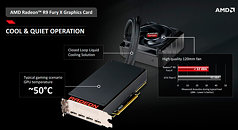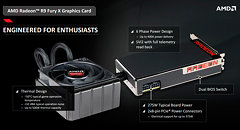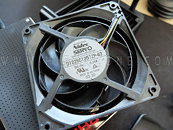Monday, June 22nd 2015

AMD "Fiji" Block Diagram Revealed, Runs Cool and Quiet
AMD's upcoming flagship GPU silicon, codenamed "Fiji," which is breaking ground on new technologies, such as HBM, memory-on-package, a specialized substrate layer that connects the GPU with it, called Interposer; features a hefty feature-set. More on the "Fiji" package and its memory implementation, in our older article. Its block diagram (manufacturer-drawn graphic showing the GPU's component hierarchy), reveals a scaling up, of the company's high-end GPU launches over the past few years.
"Fiji" retains the quad Shader Engine layout of "Hawaii," but packs 16 GCN Compute Units (CUs), per Shader Engine (compared to 11 CUs per engine on Hawaii). This works out to a stream processor count of 4,096. Fiji is expected to feature a newer version of the Graphics CoreNext architecture than "Hawaii." The TMU count is proportionately increased, to 256 (compared to 176 on "Hawaii"). AMD doesn't appear to have increased the ROP count, which is still at 64. The most significant change, however, is its 4096-bit HBM memory interface, compared to 512-bit GDDR5 on "Hawaii."At its given clock speeds, of up to 1050 MHz core, with 500 MHz memory (512 GB/s bandwidth), on the upcoming Radeon R9 Fury X graphics card, "Fiji" offers a GPU compute throughput of 8.6 TFLOP/s, which is greater than the 7 TFLOP/s rated for NVIDIA's GeForce GTX Titan X. The reference board may draw power from a pair of 8-pin PCIe power connectors, but let that not scare you. Its typical board power is rated at 275W, just 25W more than the GTX Titan X, for 22% higher SPFP throughput (the two companies may use different methods to arrive at those numbers).
AMD claims that the reference cooling solution will pay heavy dividends in terms of temperatures and noise. In a typical gaming scenario, the temperatures will be around 50°C, and noise output under 32 dB. To put these into perspective, the reference NVIDIA GeForce GTX Titan X, sees its load temperatures reach 84°C, and its fan puts out 45 dB, in our testing. The cooling solution is confirmed to feature a Nidec-Servo made 120 mm fan. As with all flagship graphics cards over the past few generations, Radeon R9 Fury X will feature dual-BIOS, and ZeroCore (which powers down the GPU when the display-head is idling, and completely powers down non-primary GPUs in CrossFire setups, unless 3D loads warrant the driver to power them back up).
The Radeon R9 Fury X will be priced at US $649.99, and will be generally available in the next 3 or so weeks.
Source:
Hispazone
"Fiji" retains the quad Shader Engine layout of "Hawaii," but packs 16 GCN Compute Units (CUs), per Shader Engine (compared to 11 CUs per engine on Hawaii). This works out to a stream processor count of 4,096. Fiji is expected to feature a newer version of the Graphics CoreNext architecture than "Hawaii." The TMU count is proportionately increased, to 256 (compared to 176 on "Hawaii"). AMD doesn't appear to have increased the ROP count, which is still at 64. The most significant change, however, is its 4096-bit HBM memory interface, compared to 512-bit GDDR5 on "Hawaii."At its given clock speeds, of up to 1050 MHz core, with 500 MHz memory (512 GB/s bandwidth), on the upcoming Radeon R9 Fury X graphics card, "Fiji" offers a GPU compute throughput of 8.6 TFLOP/s, which is greater than the 7 TFLOP/s rated for NVIDIA's GeForce GTX Titan X. The reference board may draw power from a pair of 8-pin PCIe power connectors, but let that not scare you. Its typical board power is rated at 275W, just 25W more than the GTX Titan X, for 22% higher SPFP throughput (the two companies may use different methods to arrive at those numbers).
AMD claims that the reference cooling solution will pay heavy dividends in terms of temperatures and noise. In a typical gaming scenario, the temperatures will be around 50°C, and noise output under 32 dB. To put these into perspective, the reference NVIDIA GeForce GTX Titan X, sees its load temperatures reach 84°C, and its fan puts out 45 dB, in our testing. The cooling solution is confirmed to feature a Nidec-Servo made 120 mm fan. As with all flagship graphics cards over the past few generations, Radeon R9 Fury X will feature dual-BIOS, and ZeroCore (which powers down the GPU when the display-head is idling, and completely powers down non-primary GPUs in CrossFire setups, unless 3D loads warrant the driver to power them back up).
The Radeon R9 Fury X will be priced at US $649.99, and will be generally available in the next 3 or so weeks.





73 Comments on AMD "Fiji" Block Diagram Revealed, Runs Cool and Quiet
Really would not mind that cooler shroud in my case, I would want to implement my own cooling solution while keeping that shroud intact.
*sorry for feeding the trolls*
Isn't that a much better title?
I take it that techpowerup received their review samples.
But as always, game benchmarks and independent reviews will tell the truth. I wonder if they fixed the idle and BluRay playback power leakage...
*Measuring procedures may vary between brand.
Nvidia still wins
And next year when nvidia start using HBM memory amd will surely die, because it can't keep up with the advancement in technology that nvidia r&d team have.
Still, this is a good card... But not as good as the 980ti.
Faster than Titan X, or close to it.
Single GPU support absolutely on par with the opposition.
I'll buy two, use one in PC and use other to smack you around the head with.
This comes from a owner of a GTX 970.